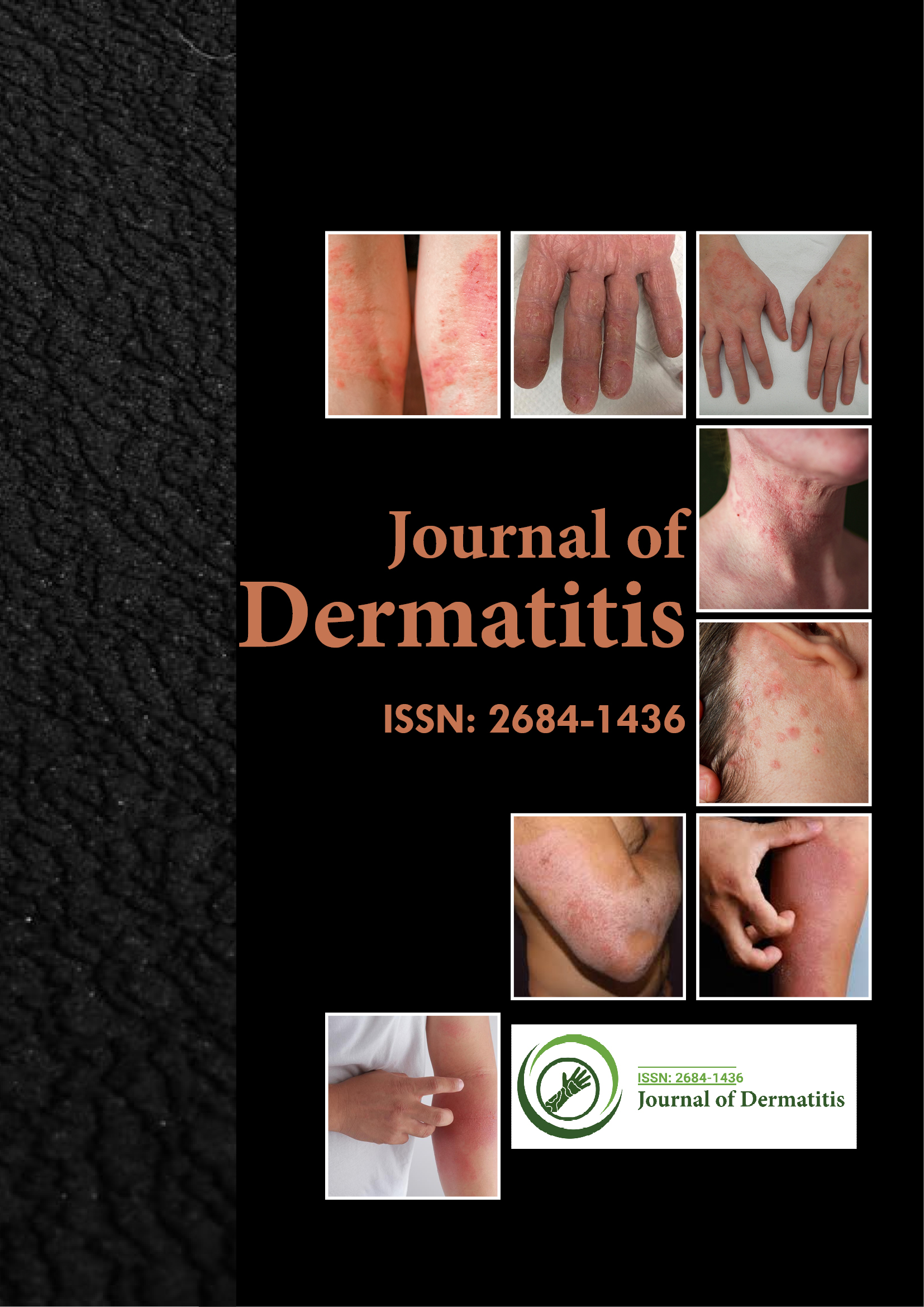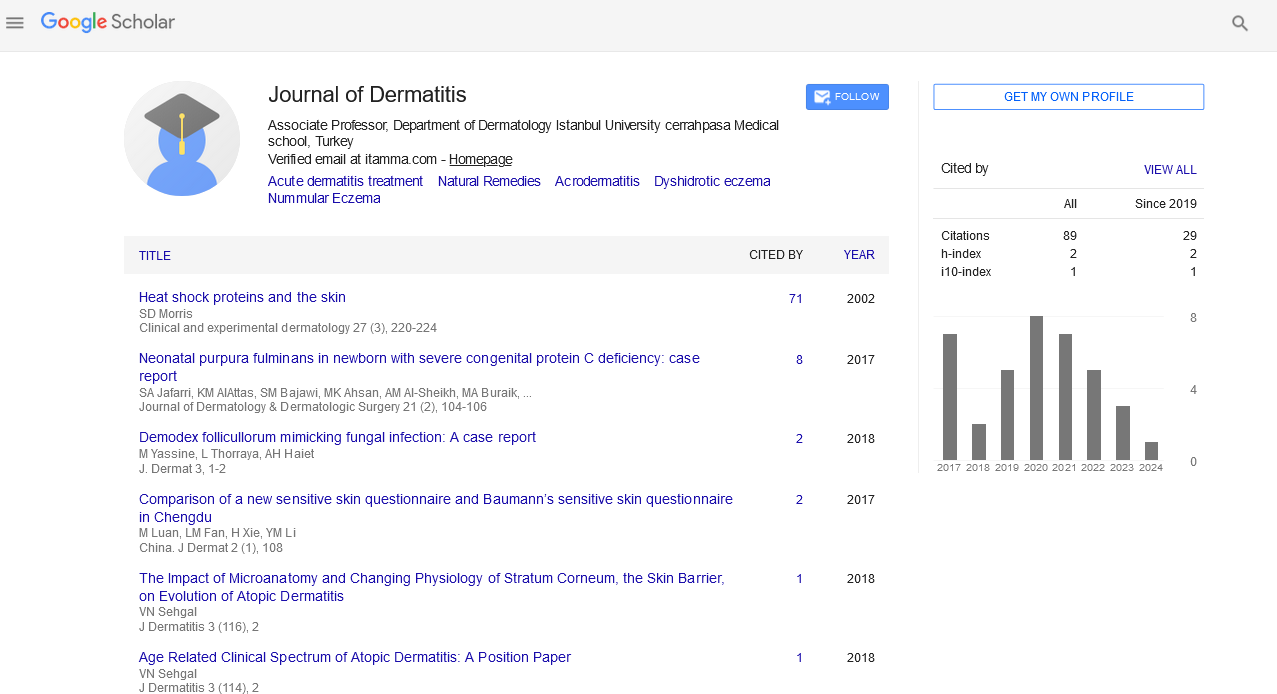Indexed In
- RefSeek
- Hamdard University
- EBSCO A-Z
- Euro Pub
- Google Scholar
Useful Links
Share This Page
Journal Flyer

Open Access Journals
- Agri and Aquaculture
- Biochemistry
- Bioinformatics & Systems Biology
- Business & Management
- Chemistry
- Clinical Sciences
- Engineering
- Food & Nutrition
- General Science
- Genetics & Molecular Biology
- Immunology & Microbiology
- Medical Sciences
- Neuroscience & Psychology
- Nursing & Health Care
- Pharmaceutical Sciences
Commentary - (2022) Volume 7, Issue 5
Symptoms of Necrotizing Fasciitis on the Skin
Mouna Agarwal*Received: 01-Sep-2022, Manuscript No. JOD-22-18169; Editor assigned: 05-Sep-2022, Pre QC No. JOD-22-18169 (PQ); Reviewed: 19-Sep-2022, QC No. JOD-22-18169; Revised: 26-Sep-2022, Manuscript No. JOD-22-18169 (R); Published: 03-Oct-2022, DOI: 10.35248/2684-1436.22.7.162
Description
The insidious spread of necrotizing fasciitis, a deadly soft tissue infection, throughout the fascia is well recognised. A variety of bacteria operating alone or as part of a polymicrobial infection may cause this syndrome. Although other bacteria or streptococcal serotypes can cause necrotizing fasciitis, group A beta-hemolytic streptococci are the ones most closely linked to the disease. Although hospital mortality (9.3%) remained consistent, necrotizing fasciitis cases increased in Texas between 2001 and 2002 and 2009 and 2010. In comparison, there were 5.9 versus 7.6 cases per 100,000 individuals. A nationwide French investigation revealed 1537 people with a median age of 60; 23.7% of them passed away. Due to an increase in litigation across many countries, necrotizing fasciitis has been the subject of numerous malpractice lawsuits, including those brought by people with disabilities. 1537 cases were found in a French study, with a median age of 60 and a mortality rate of 23.7%. Due to the increased litigious atmosphere in many countries, necrotizing fasciitis has been the subject of a number of malpractice lawsuits, including from disability following successful outcomes from lifesaving major surgery [1].
Subcutaneous tissue necrosis follows a rapidly advancing inflammatory fascial infection known as necrotizing fasciitis. The rate of spread is directly correlated with the thickness of the subcutaneous layer.
Necrotizing fasciitis is also known as acute dermal gangrene, hospital gangrene, hemolytic streptococcal gangrene, suppurative fasciitis, and synergistic necrotizing cellulitis. Provider gangrene is a unique form of necrotizing fasciitis that affects the scrotum and perineum [2].
Bacteria from mixed flora, aerobic, or anaerobic environments may be to blame. A few unique necrotizing fasciitis syndromes should be recognised.
The 3 most important are as follows:
• The polymicrobial Type I
• Group a streptococcal type II
• Clostridial myonecrosis, often known as type III gas gangrene
A skin wound that first seems to be small becomes infected with saltwater that contains a Vibrio species, causing saltwater necrotizing fasciitis, a kind of necrotizing fasciitis type I.
Because the presence of organisms that create gas causes necrotizing fasciitis, subcutaneous air is commonly used to describe the condition. If at all, only radiographs could reveal this [3].
Understanding necrotizing fasciitis may aid in an earlier diagnosis and the beginning of the appropriate course of treatment. This infection may develop as a side effect from a variety of surgical procedures, medical conditions, including cardiac catheterization, vein sclerotherapy, and diagnostic laparoscopy, among others. Necrotizing fasciitis can arise in many places after different encounters, such as after a stonefish sting, after a shoulder sprain in a previously healthy person, on a swollen breast, or as an acne complication that initially looks like lip cellulitis. One possible presentation is bilateral necrotizing fasciitis with or without orbital involvement. Necrotizing fasciitis of the head and neck, which could be brought on by an odontogenic infection, has a terrible prognosis [4].
Type I polymicrobial necrotizing fasciitis generally appears after an operation or other traumatic event. At first glance, this kind might be mistaken for a simple case of wound cellulitis. The intense pain and systemic poisoning, however, are clear signs of the widespread tissue necrosis that exists beneath the skin's outward appearance of health. This stage of the illness may also be accompanied by anogenital or urogenital infections [5].
Group A streptococcal necrotizing fasciitis, also known as type II, is the so-called "flesh-eating" bacterial infection. Gas gangrene is a kind III necrotizing fasciitis, sometimes referred to as clostridial myonecrosis. This skeletal muscle infection could be related to recent surgery or trauma.
The term "fungal necrotizing fasciitis" refers to the fourth form. Because a fungus is rarely the cause of necrotizing fasciitis or a contributing component, the authors of this Medscape Reference article classified necrotizing fasciitis as type IV. In any situation, an early fungal smear and culture should be taken into account. The aetiology may be caused by candidal species, possibly in association with a bacterial one like Streptococcus pyogenes [6].
An increase in necrotizing fasciitis cases has been associated with an increase in immunocompromised patients with diabetes mellitus, cancer, alcoholism, vascular insufficiencies, organ transplants, HIV infection, or neutropenia [7].
Ages of necrotizing fasciitis patients often range from 38 to 44. This condition rarely affects children. Children's cases have been reported in low-resource nations with a general lack of hygiene. These infections can be difficult to identify at first, but they spread swiftly. Intensive therapy is required to combat the high rates of morbidity and mortality linked to them.
REFERENCES
- Lee SY, Ham Y H, Ok ON, Kim EJ, Kwon IG, Hwang MS et al. The Effects of Foot Reflexology on Peripheral Neuropathy, Symptom Distress, Anxiety and Depression in Cancer Patients Treated with Oxaliplatin. Asian Oncol Nurs. 2012;12(4): 305-313. [Crossref],
- Quattrin R, Zanini A, Buchini S, Turello D, Annunziata MA, Vidotti C et al. Use of reflexology foot massage to reduce anxiety in hospitalized cancer patients in chemotherapy treatment: Methodology and outcomes. J Nurs Manag. 2006;14(2):96–105. [Crossref], [PubMed], [Google Scholar]
- Stephenson NLN, Swanson M, Dalton JA, Keefe F J. Engelke M. Partner-delivered reflexology: effects on cancer pain and anxiety. Oncol Nurs Forum. 2007;34(1):127–132. [Crossref], [Pubmed],
- Embong NH, Soh YC, Ming LC, Wong TW. Revisiting reflexology: concept, evidence, current practice, and practitioner training. J Tradit Complement Med. 2015; 5(4):197–206. [Crossref], [PubMed],
- Steflitsch W, Steflitsch M. Clinical aromatherapy. J Men’s Health. 2008;5(1):74–85. [Crossref], [PubMed],
- Rustgi AK. The genetics of hereditary colon cancer. Genes Dev. 2007;21(20):2525-2538. [Crossref], [PubMed],
- Nissa C, Wada F H, Astuti P, Batubara ST, Prima A. Studi Literatur : Pengaruh Pijat Refleksi Kaki Terhadap Gangguan Tidur Pada lansia. J Ilmiah Keper Imel, 2021;7(1):8–13. [Crossref],
Citation: Agarwal M (2022) Symptoms of Necrotizing Fasciitis on the Skin. J Dermatitis.7:162.
Copyright: © 2022 Agarwal M. This is an open-access article distributed under the terms of the creative commons attribution license which permits unrestricted use, distribution and reproduction in any medium, provided the original author and source are credited.

